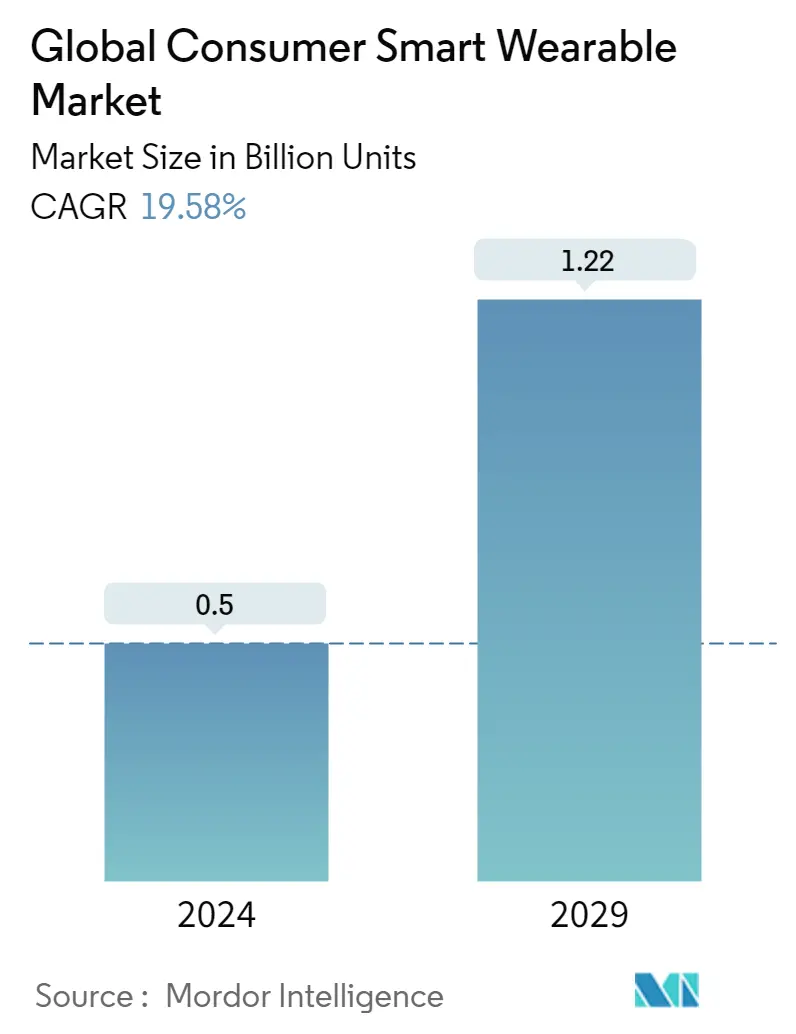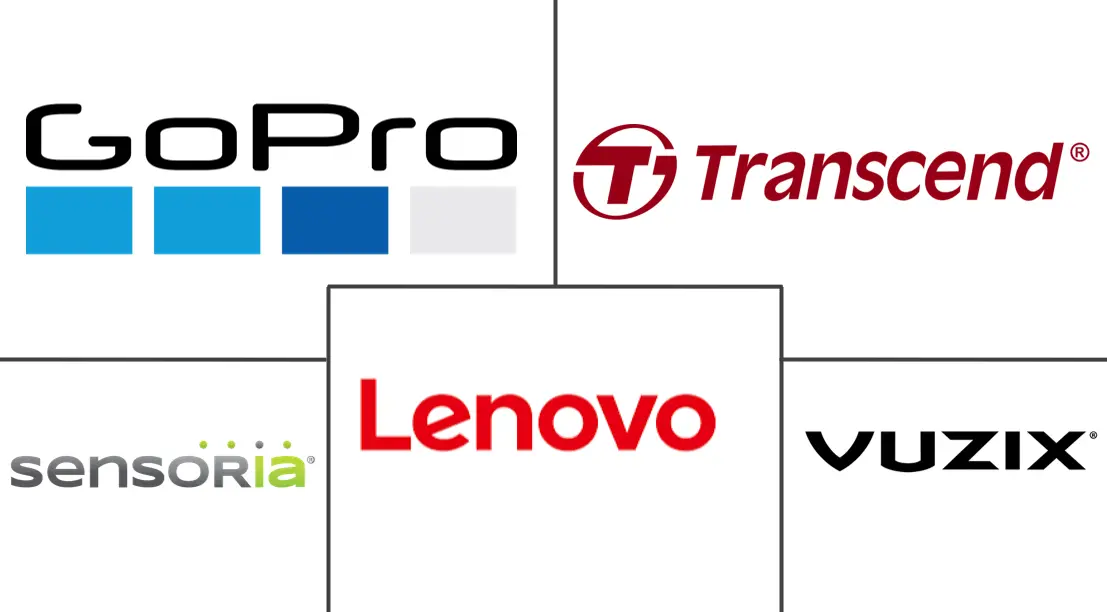Market Size of Global Consumer Smart Wearable Industry

| Study Period | 2019 - 2029 |
| Market Volume (2024) | 0.50 Billion units |
| Market Volume (2029) | 1.22 Billion units |
| CAGR (2024 - 2029) | 19.58 % |
| Fastest Growing Market | Asia-Pacific |
| Largest Market | Asia-Pacific |
| Market Concentration | Low |
Major Players
*Disclaimer: Major Players sorted in no particular order |
Consumer Smart Wearable Market Analysis
The Global Consumer Smart Wearable Market size is estimated at 0.5 Billion units in 2024, and is expected to reach 1.22 Billion units by 2029, growing at a CAGR of 19.58% during the forecast period (2024-2029).
Wearable technology, an emerging trend, integrates electronics into daily activities and addresses the changing lifestyles with the ability to be worn on any part of the body. Factors such as the ability to connect to the internet and provide data exchange options between a network and a device are leading to the trend of wearable technology.
- The rising penetration rates of urbanization in various parts of the world have driven the demand for advanced, aesthetically appealing products that possess the ability to serve the consumers' requirements better, such as multiple features in one device and time schedules. Moreover, the vast millennial population across the globe has been quick to adopt smartwatches, owing to the increased spending ability on their regular work hours tracking and luxury standards.
- Machine learning and AI capabilities take skills to the next level, especially in the current healthcare industry. In support of this, IoT compatibles smart wearable sensors are also witnessing a decline in pricing, which leads to manufacturers offering smart wearable devices at a more affordable rate, thus, encouraging various industries to adopt products catered to their systems and operations. Additionally, there has been a significant increase in consumer smart wearable devices being sold over the past few years. Additionally, wearable sensor devices have emerged to be a significant part of the sports industry, thereby helping customers to stick to daily routines and providing crucial information regarding the different parameters it is programmed to monitor.
- Smart wearables are further witnessing a surge in the number of new users, including the older age population, owing to the fact that wearable makers, such as Apple and Fitbit, among others, are adding health-monitoring features that appeal to old age people and keep them updated about their health status in real-time.
- Although the adoption of wearables has been widely gaining traction over the past few years, the concern over data privacy persists. Even though data from smart wearables may be of little value to attackers, the risk increases for smart wearables like smartwatches. Risks are likely to increase further if the device comes with an LTE connection, as they can be operated away from the paired device.
- The COVID-19 outbreak and the lockdown restrictions across the globe have affected the consumer across the world. Some of the effects of lockdown include supply chain disruptions, lack of availability of raw materials used in the manufacturing process, labor shortages, fluctuating prices that could cause the production of the final product to inflate and go beyond budget, and shipping problems, among others.
Consumer Smart Wearable Industry Segmentation
Wearable technology is an emerging trend that integrates electronics into daily activities and fits into the changing lifestyles, and it can be worn on any part of the body. The market is divided based on product types, such as a smartwatch, head-mounted displays, smart clothing, ear-worn, fitness trackers, and body-worn camera, which are mainly identified as consumer smart wearables.
The Global Consumer Smart Wearable Market is segmented by Product (Smartwatches, Head-mounted Displays, Smart Clothing, Ear Worn, Fitness trackers, Body-Worn cameras) and Geography.
| By Product | |
| Smartwatches | |
| Head-mounted Displays | |
| Smart Clothing | |
| Ear Worn | |
| Fitness Trackers | |
| Body-worn Cameras |
| By Geography | |||||||
| |||||||
| |||||||
| |||||||
| Latin America | |||||||
| Middle East and Africa |
Global Consumer Smart Wearable Market Size Summary
The Global Consumer Smart Wearable Market is experiencing significant growth, driven by the integration of wearable technology into daily life and its ability to adapt to evolving consumer lifestyles. This market is characterized by the increasing demand for devices that offer multiple features, such as health monitoring and connectivity, appealing particularly to the millennial demographic and older populations. The adoption of smart wearables is further bolstered by advancements in machine learning, AI, and IoT-compatible sensors, which enhance functionality and affordability. Despite concerns over data privacy, the market continues to expand, supported by new product launches and the entry of numerous companies aiming to differentiate their offerings. The COVID-19 pandemic has posed challenges, including supply chain disruptions, but has also highlighted the importance of wearable technology in various sectors like healthcare, sports, and fitness.
The competitive landscape of the Global Consumer Smart Wearable Market is marked by rapid innovation and strategic partnerships among key players. Companies such as Apple, Fitbit, Xiaomi, and Huawei are at the forefront, developing advanced technologies and collaborating with service providers to enhance their product offerings. The market is also witnessing significant contributions from Chinese and Japanese firms, with advancements in flexible batteries and head-mounted displays, respectively. Additionally, the Indian market is poised for growth, further fueling the demand for smart wearables. As companies continue to invest in research and development, the market is expected to see further expansion, with a focus on integrating wearable technology into various industries and everyday applications.
Global Consumer Smart Wearable Market Size - Table of Contents
-
1. MARKET DYNAMICS
-
1.1 Market Drivers
-
1.1.1 Incremental Technological Advancements Aiding the Market Growth
-
-
1.2 Market Challenges
-
1.2.1 High Cost and Data Security Concerns
-
-
-
2. MARKET SEGMENTATION
-
2.1 By Product
-
2.1.1 Smartwatches
-
2.1.2 Head-mounted Displays
-
2.1.3 Smart Clothing
-
2.1.4 Ear Worn
-
2.1.5 Fitness Trackers
-
2.1.6 Body-worn Cameras
-
-
2.2 By Geography
-
2.2.1 North America
-
2.2.1.1 United States
-
2.2.1.2 Canada
-
-
2.2.2 Europe
-
2.2.2.1 United Kingdom
-
2.2.2.2 Germany
-
2.2.2.3 France
-
2.2.2.4 Rest of Europe
-
-
2.2.3 Asia Pacific
-
2.2.3.1 China
-
2.2.3.2 Japan
-
2.2.3.3 India
-
2.2.3.4 South Korea
-
2.2.3.5 Rest of Asia Pacific
-
-
2.2.4 Latin America
-
2.2.5 Middle East and Africa
-
-
Global Consumer Smart Wearable Market Size FAQs
How big is the Global Consumer Smart Wearable Market?
The Global Consumer Smart Wearable Market size is expected to reach 0.50 billion units in 2024 and grow at a CAGR of 19.58% to reach 1.22 billion units by 2029.
What is the current Global Consumer Smart Wearable Market size?
In 2024, the Global Consumer Smart Wearable Market size is expected to reach 0.50 billion units.

